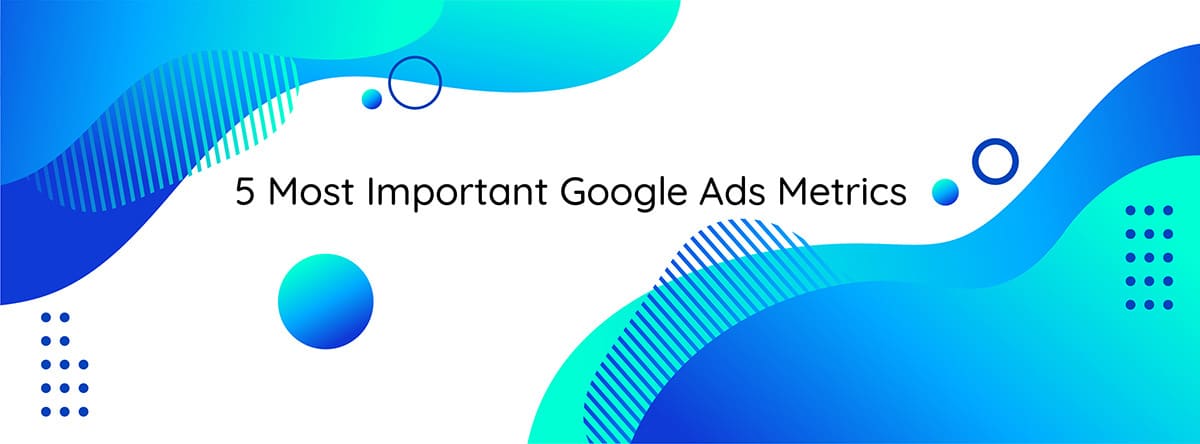It can be overwhelming with so many numbers to look at in Google Ads. What are the most important metrics to track in Google Ads?

There are more than five important metrics to track in Google Ads. However, for beginners, these are usually the most important ones. The 5th and final metric is more advanced for those more savvy in the Google Ads platform. Let’s dive right in!
Cost
This should be a given, right? One of the first things you’ll decide before you even start a Google Ads Campaign is what your budget is. Know your monthly and daily budget, and monitor it within the platform.
Don’t be alarmed if and when you see you have gone over your daily budget when looking at your cost. Google is allowed to spend twice the amount of your budget on any given day if they feel it will help increase your conversions. Don’t worry; they assure you they will stay within your monthly budget. For example, if they spend twice your daily budget today, they may spend less than your daily budget tomorrow to keep you within your monthly budget.
This metric should be pretty hands-off, but it’s important to view when looking at your cost over a certain timeline. i.e.) What have you spent on ads in the last six months? How about the previous year? You can even look at that compared to the prior period or year and then compare this column to the metrics in this article.
Conversions
If you’re an eCommerce business, this is pretty straightforward. A conversion is a purchase, which is how many purchases you’ve had. If you’re not eCommerce, your conversion will be defined as what you set it up as in the beginning. This can be a form-fill like your website’s “Contact Us” page. Another example is a lead you get on a landing page from software such as Unbounce or Instapages. Other types of conversions can be phone calls to your business.
You’ll want to track this metric in comparison to the following metrics and the previous one to get a good look at if you’re making a healthy ROI.
Conversion Value
So far, you know how much you’ve spent and how many conversions you’ve gotten. So, how much money have you made? That is what this column is for. It’s vital to ensure you’ve set this up properly when implementing the tags on your website so that Google Ads can properly display how much money you’ve made. Again, this is easiest seen with eCommerce companies.
For non-eCommerce companies, a conversion value will be more broad. If you choose to track it, consider what an average conversion value looks like. For example, if one conversion is one lead, and one closed lead averages out to $500 for your company, then track each conversion with a $500 conversion value. This is seen with service companies, firms, and so forth. While these values will not be 100% accurate, if you have an average value of what one conversion looks like, you can get somewhat of a better idea of if your advertising is monetarily beneficial.
Cost/Conv
Here is one of the most important numbers to see if your ads are financially beneficial. Your cost per conversion is how much money you spend to get a conversion (on average).
For example, if it costs your company $5 to sell a $10 product, and your cost/conv on ads is higher than $10, you’re losing money. If it’s $5, you’re breaking even. If it’s lower than $5, you’re making a profit. Here is a real-life example:
I have a client whose average order is $250. When figuring out the cost for the product, shipping, etc., and ad spend, we calculated that we needed to set a goal for a cost/conv of $85 and lower to make a profit. Our cost/conv for that client ranges about $25, so they’re making a pretty great profit off our ads.
However, it’s important to note the value of your purchases. The client I just mentioned averages $250 an order. If your products sell for a wide range of values, some $5 while others are $500, then you need to take an extra look at your Conversion Value column. Double-check your conversion value column if you’re worried about your cost/conv being too high. I once had a campaign that was costing over the goal amount cost/conv, but the conversion value was so high we were still making a vast profit for the client as we had been able to target that campaign to sell higher priced items and therefore ultimately increased our goal cost/conv amount for that particular campaign while leaving the other campaigns at the original goal.
Sorry for all the exceptions, but there are always exceptions with data (and Google)!
Conv Value/Cost
This one is for my advanced folks out there. Let’s take a look at what Google defines Conv Value/Cost and then we’ll break it down from there…
“Conversion value per cost (“Conv. value/cost”) measures your return on investment. It’s the conversion value divided by the total cost of all ad interactions.
The cost in this metric excludes interactions that can’t lead to conversions, such as those that happen when you aren’t using conversion tracking.”
Here’s an example… Let’s say your value/conversion is $50. Your cost/conv is $23. Your total conversions is 12, and your total cost is $276. The conv value/cost will be 50×12/276 = 2.2 That mean you earn 2.2 times more than you spent.
Another calculation that will get you here is 50/23 = 2.2
So, while you want to see your cost/conv nice and low, you want to see your conv value/cost increase. Make sense? Great! If not, give us a shout… we love this stuff.
You Did It!
Okay, that’s all for today! Have fun with your ads, and enjoy the numbers. If they seem overwhelming, then head back here and give us a call to see how we can help you maximize your ad spend…and ad space (but that’s for another perspective). Catch you next time!
- 5 Tactics for Increasing Black Friday and Cyber Monday Sales in 2024 - March 5, 2024
- 5 Most Important Google Ads Metrics - July 11, 2023
- What is Headless Commerce? - May 23, 2023
